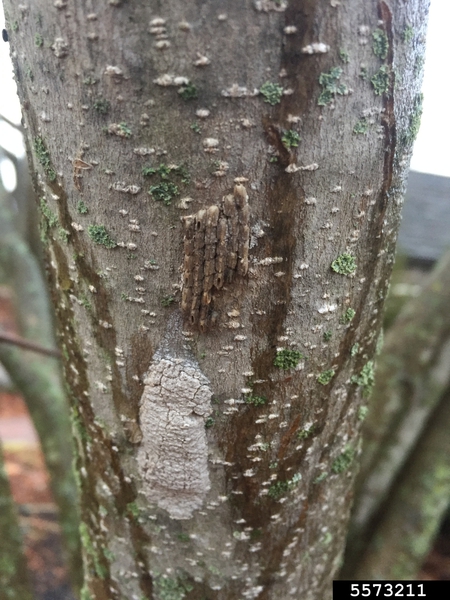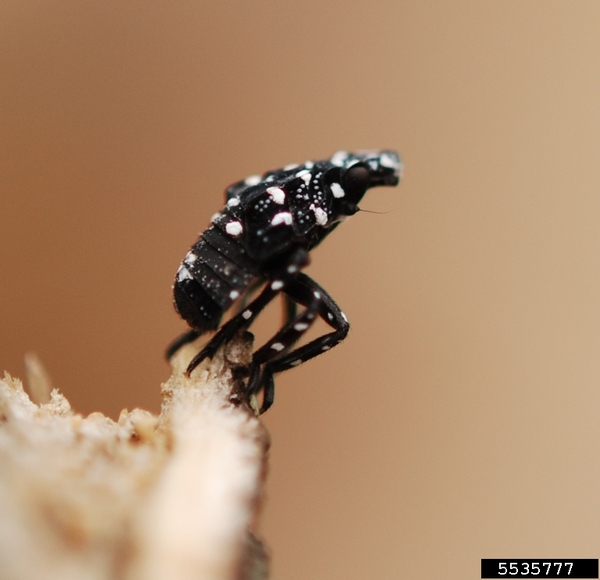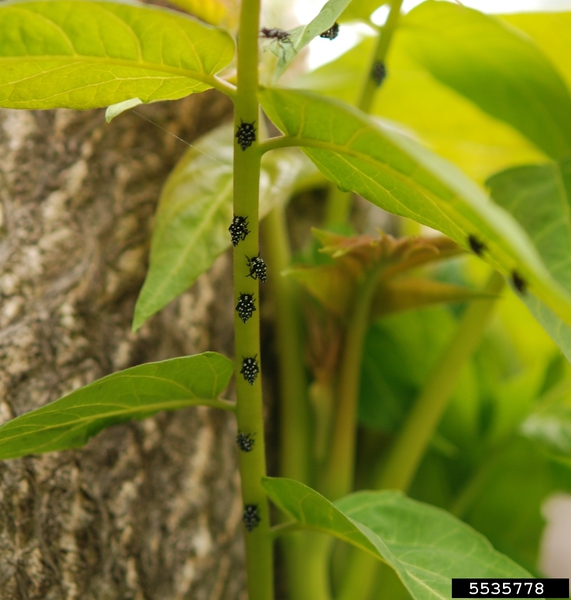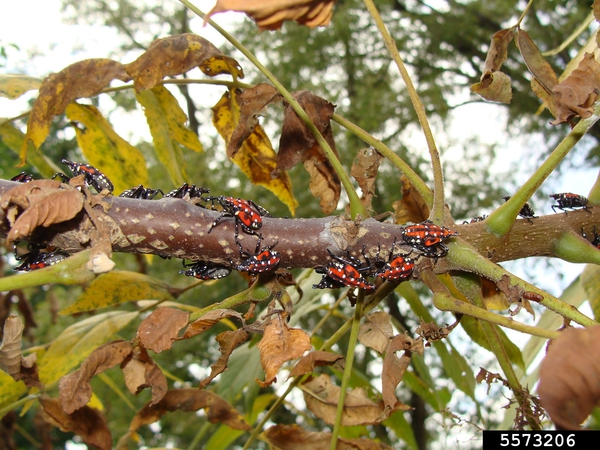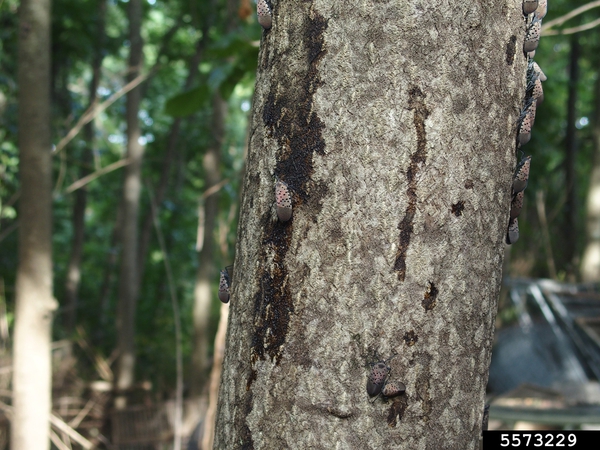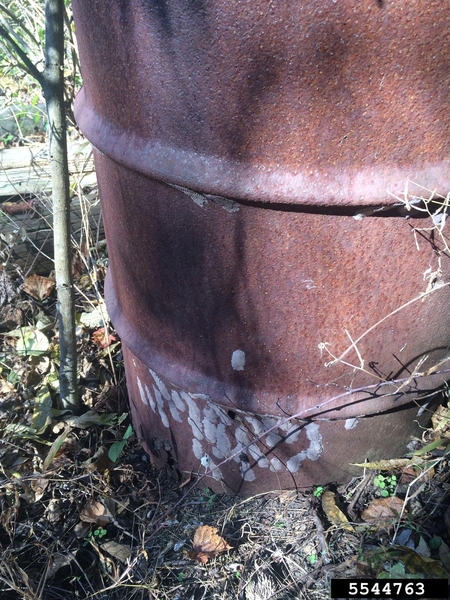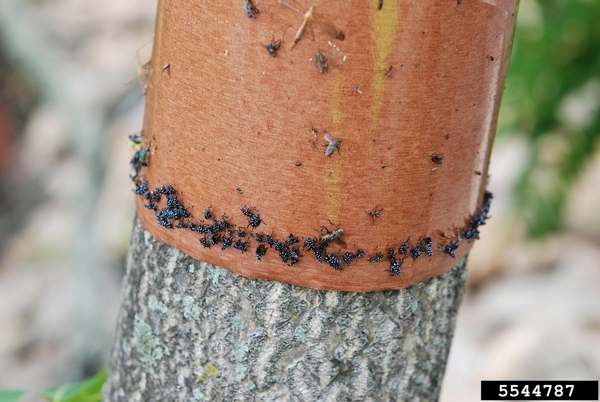Introduction
The spotted lanternfly (SLF; Lycorma delicatula) is a non-native invasive pest native to China, India, and Vietnam. It was first detected in the United States in eastern Pennsylvania (Berks County) in 2014 and is suspected to have arrived via imported goods, likely as an egg mass (Figure 3) adhered to stone products. Since its initial detection, SLF has been detected in eight additional states: New Jersey (2018), Virginia (2018), Delaware (2019), West Virginia (2019), Maryland (2019), Connecticut (2019), New York (2020), Ohio (2020), Indiana (2021), and Massachusetts (2021). Spotted lanternfly egg masses can easily be moved large distances on firewood or other (often smooth) surfaces on which females deposit eggs. In June 2022, an established population of SLF was confirmed in North Carolina for the first time.
The threat of SLF is largely as an agricultural, ornamental, and nuisance pest. Agriculturally, the threat is primarily to grapevine, in which up to 90% yield reduction of infested vineyards is documented. During heavy infestations, grapevines may be killed and mating swarms may disrupt agrotourism events at vineyards (e.g., tours, weddings). Spotted lanternflies also attack hops, fruit trees, and many ornamental plants. As a nuisance pest, SLF congregates near and in homes and businesses and landscape plants, causing aggravation among those who encounter it. Because they aggregate, copious amounts of honeydew and sooty mold accompany an infestation (Figure 6). Spotted lanternfly is not suspected to cause tree mortality, but feeding can cause oozing, wilting, or dieback and/or predispose trees to other stress agents.
Host Plants
Spotted lanternfly has a very broad host range, known to feed on over 100 species of plants (Barringer & Ciafré 2020). They have a strong preference for tree-of-heaven (Ailanthus altissima) and do not need to feed on it to complete their life cycle as previously thought (Uyi et al. 2020). Tree-of-heaven is an invasive species itself, distributed across the state and found primarily along roadways and other disturbed areas. Other host plants of SLF include: grape (Vitis), hops (Humulus lupulus), apple (Malus), plum, cherry, peach, and apricot (Prunus), sycamore (Platanus occidentalis), American beech (Fagus grandifolia), black gum (Nyssa sylvatica), black walnut (Juglans nigra), dogwood (Cornus), oak (Quercus), maple (Acer), and more.
Identification and Life Cycle
Spotted lanternfly overwinters as an egg mass that contains 30-50 eggs (Figure 3). Egg masses are grayish-brown and 1-1.5” long and ½ - ¼” wide. When they are newly laid, they are shiny but upon hardening, they look like dried mud. After hatching, individual eggs can be seen arranged in columns and look like are brown and seed-like. Egg masses can most likely be observed from mid-October to spring in North Carolina.
Young SLF (nymphs) emerge in spring or early summer. Upon emergence, young nymphs are black with white spots on its body and legs (Figure 4, Figure 7). When they reach the last stage as a nymph, red patches appear on its body (Figure 5, Figure 8).
Adult SLF (Figure 1) reach 1” long and ½” wide. Their wings are held folded tent-like over their bodies and are light brown-gray with black spots and black speckles at the tips. Their head and legs are black. If the forewings are pried up, bright red hindwings with black spots and black banded tips are visible (Figure 2). These hindwings are typically not visible when SLF is at rest. Their body (abdomen) is typically concealed by the wings and is yellow on the outer edges with a broad black band down the center. In North Carolina, adults are expected from late summer through November. During this period, they feed, mate, and lay egg masses. They do not bite or sting in any life stage.
They have one generation per year and emerge sooner in North Carolina than they do in more northern states (Figure 10).
A few insects in North Carolina are commonly misidentified as SLF (Figure 9): the ornate bella moth (Utetheisa ornatrix), the harnessed tiger moth (Apantesis fgurata), and the ailanthus webworm moth (Atteva aurea). The ornate bella moth has orange on its forewings whereas SLF only had red on its underwings; the harness tiger moth does not have spots on its forewings despite similar coloration; and, the Ailanthus webworm moth is much smaller and also has orange on its forewings. A guide with more species similar in appearance can be found on the NCDA&CS Spotted Lanternfly page.

Figure 9. Spotted lanternfly alongside insects commonly mistaken for it in North Carolina.
E. Swackhamer, Penn State University (top, side view); L. Barringer, Pennsylvania Dept. of Agriculture (SLF wings spread); E. McGriff, Univ. of Georgia (ornate bella moth); M. Dreiling (tiger moth), D. Cappaert (Ailanthus webworm moth), Bugwood.org.
Damage
Spotted lanternfly use piercing-sucking mouthparts to feed on plant phloem while nymphs and adults. Their feeding retrieves nutrients from the plant, weakening it, reducing photosynthesis, and making plants more susceptible to other stress agents. This can cause significant reduction in growth and crop production for agricultural commodities. In rare cases, SLF has killed young or not-yet-established plants.
Of particular concern is SLF's impact to viticulture. Both Old World and New World grapes are attacked, reducing sugar content in fruit and vine cold hardiness. Untreated vineyards can be completely destroyed in three years. Adult SLF swarm mid-September to mid-October, which can lead to restricted treatment options prior to grape harvest.
As a sucking insect, SLF excretes large amounts of honeydew which is exacerbated by their gregarious behavior. Sooty mold, a fungus that grows on honeydew, is also quite prevalent. In small quantities, sooty mold is generally harmless, but in excess, it can block plant photosynthetic capabilities and be an aesthetic nuisance to homeowners. Spotted lanternfly feeding sites may also ooze sap and be accompanied by a fermented smell (Figure 11), which often attracts other insects like yellow jackets, bees, ants, and flies.
Because of their gregarious habit, SLF is an incredible nuisance. They impact business owners (e.g., a restaurant in an infested area was forced to open a side door because SLF clustered on their main door for days) and tourism. Vineyards are also a popular place for weddings; those infested with SLF might become less desirable.
Range Expansion and Quarantine
Adult SLF can disperse on their own, but natural dispersal is limited. The larger threat is the accidental movement of SLF-infested materials or the insects themselves from place to place by human activity. Spotted lanternfly egg masses are laid on tree bark and smooth-surface, man-made items (Figure 12). Moving items that have egg masses can easily and quickly move SLF long distances and infest new areas. The introduction of SLF to the U.S. is believed to have occurred this way, as an egg mass stowaway within a stone shipment. They can also be moved as a live insect when infested plant materials are moved from place to place.
When leaving an infested area, one should always check their car, firewood, or outdoor equipment (grills, RVs, mowers) for the presence of any life stage of this insect. Many non-native invasive species (e.g., emerald ash borer, redbay ambrosia beetle) can be accidentally transported in infested wood material. Therefore, it is highly recommended that untreated firewood be burned within 50 miles of where it was cut. If firewood must be transported, heat-treated or kiln-dried firewood should be used.
When SLF is detected in a new area, state and federal quarantines are established to regulate movement of material potentially infested with SLF in an effort to reduce its spread.
Reporting and Management
When an infestation of SLF is detected in North Carolina, the N.C. Department of Agriculture & Consumer Services – Plant Industry Division (PID) will respond immediately to manage or eradicate the population if feasible. In North Carolina, suspect SLF infestations should be reported to PID by using their online reporting tool.
Homeowners within the quarantined areas are encouraged to scrape and destroy egg masses, use sticky bands or traps (Figure 13), remove preferred host plants, and use registered insecticides when appropriate.
Other Resources
NCDA&CS' Spotted Lanternfly Page
NCDA&CS’ Spotted Lanternfly Pest Watch
N.C. Forest Service: Forest Health Notes
References
Barringer, L. and C. M. Ciafré. 2020. Worldwide feeding host plants of spotted lanternfly, with significant additions from North America. Environ. Entomol. 49(5): 999-1011.
Uyi, O., J.A. Keller, A. Johnson, D. Long, B. Walsh, and K. Hoover. 2020. Spotted lanternfly (Hemiptera: Fulgoridae) can complete development and reproduce without access to the preferred host, Ailanthus altissima. Environ. Entomol. 49(5): 1185–1190.
Publication date: April 23, 2021
N.C. Cooperative Extension prohibits discrimination and harassment regardless of age, color, disability, family and marital status, gender identity, national origin, political beliefs, race, religion, sex (including pregnancy), sexual orientation and veteran status.



